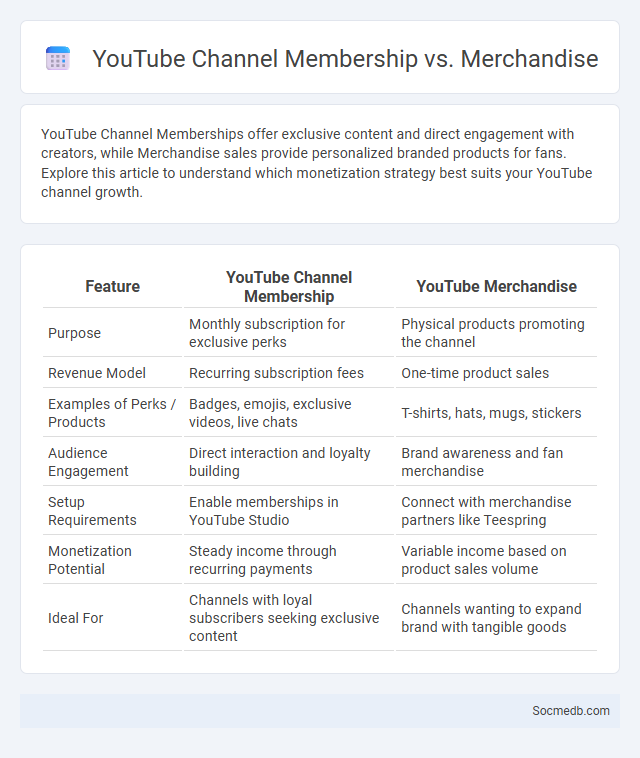
Photo illustration: YouTube Channel Membership vs Merchandise
YouTube Channel Memberships offer exclusive content and direct engagement with creators, while Merchandise sales provide personalized branded products for fans. Explore this article to understand which monetization strategy best suits your YouTube channel growth.
Table of Comparison
| Feature | YouTube Channel Membership | YouTube Merchandise |
|---|---|---|
| Purpose | Monthly subscription for exclusive perks | Physical products promoting the channel |
| Revenue Model | Recurring subscription fees | One-time product sales |
| Examples of Perks / Products | Badges, emojis, exclusive videos, live chats | T-shirts, hats, mugs, stickers |
| Audience Engagement | Direct interaction and loyalty building | Brand awareness and fan merchandise |
| Setup Requirements | Enable memberships in YouTube Studio | Connect with merchandise partners like Teespring |
| Monetization Potential | Steady income through recurring payments | Variable income based on product sales volume |
| Ideal For | Channels with loyal subscribers seeking exclusive content | Channels wanting to expand brand with tangible goods |
Introduction to YouTube Monetization Options
YouTube monetization involves several key options such as AdSense, channel memberships, Super Chat, and merchandise shelf integration, which allow creators to generate revenue from their content. AdSense integrates targeted ads into videos, earning income based on views and clicks, while channel memberships offer exclusive perks to subscribers in exchange for a monthly fee. Features like Super Chat enable fans to financially support creators during live streams, enhancing engagement and revenue potential on the platform.
What Is YouTube Channel Membership?
YouTube Channel Membership is a paid subscription feature that allows viewers to support their favorite creators by paying a monthly fee in exchange for exclusive perks such as custom badges, emojis, and members-only content. This feature enhances creator revenue and fosters a closer community by offering unique engagement opportunities. Members gain access to special live chats, behind-the-scenes videos, and early access to new uploads, directly benefiting both creators and subscribers.
How Does YouTube Merchandise Work?
YouTube Merchandise allows creators to sell branded products directly to their audience through an integrated platform linked to their channel. Your fans can browse and purchase items like apparel, accessories, and collectibles displayed beneath your videos or on your channel page. This seamless integration simplifies the buying process while providing creators with an additional revenue stream connected to their content and viewer engagement.
Key Features of Channel Membership
Channel Membership on social media platforms offers exclusive perks such as custom badges, access to members-only live chats, and unique emojis that enhance viewer engagement. Members receive priority content like behind-the-scenes videos and early access to new uploads, fostering a loyal community. Creators benefit from predictable revenue streams and direct interaction with their most dedicated followers, boosting overall channel growth.
Key Benefits of Selling YouTube Merchandise
Selling YouTube merchandise boosts creator revenue by diversifying income streams beyond ad revenue and sponsorships. It strengthens fan engagement by offering unique, branded products that foster community loyalty and enhance viewer connection. Leveraging YouTube's integrated merchandise shelf provides seamless shopping experiences, increasing conversion rates and maximizing sales potential.
Revenue Potential: Channel Membership vs Merchandise
Channel Membership offers a steady revenue stream by providing exclusive content and perks that encourage viewer loyalty and repeated subscriptions. Merchandise sales generate income by transforming your brand into physical products, appealing directly to your audience's desire to support and showcase their affiliation. Your choice between these revenue potentials should align with your audience engagement level and brand identity to maximize financial returns.
Audience Engagement: Membership vs Merchandise
Audience engagement thrives when You balance membership programs offering exclusive content and communities with merchandise that builds brand loyalty and visibility. Memberships foster deeper connections through personalized interaction and ongoing value, while merchandise transforms fans into walking promoters, increasing organic reach. Combining both strategies maximizes engagement by catering to different audience motivations and participation levels.
Requirements and Eligibility for Each Option
Social media platforms have specific requirements and eligibility criteria based on user age, location, and account type to ensure compliance with legal standards and platform policies. You must meet minimum age limits, typically 13 or older, and provide accurate personal information during registration to access features like advertising or business accounts. Verification processes often include identity confirmation or content guidelines adherence to maintain account eligibility and avoid restrictions.
Pros and Cons: Channel Membership vs Merchandise
Channel Membership offers recurring revenue through subscriber support, fostering a loyal community with exclusive content and perks that enhance viewer engagement. Merchandise sales provide a tangible product, allowing creators to monetize their brand and expand visibility beyond digital platforms, but require inventory management and upfront costs. Balancing Membership for steady income and Merchandise for brand growth helps maximize social media monetization.
Choosing the Best Monetization Strategy for Your Channel
Selecting the best monetization strategy for your social media channel depends on analyzing audience demographics, engagement rates, and content type to maximize revenue potential. Popular methods include sponsored content, affiliate marketing, merchandise sales, and ad revenue sharing programs like YouTube AdSense or Instagram Shopping. Leveraging detailed analytics tools helps tailor strategies, optimize conversions, and sustain long-term channel growth.
 socmedb.com
socmedb.com